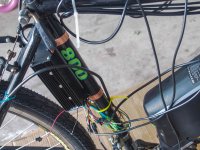Working on a plan to clean up my build and add some better mounting options.
Plan is to use some scrap galvanized sheet metal contractors left in the scrap bin at work, Bend and cut DIY style. Yes it will be "Custom" and not as clean as most, but that is kinda the point.
Question is: Will drilling 1/8th inch holes for riveting compromise the upper and lower tube?
----------
MTB Apperently 6061 Aluminum but its a Wally World donor
EBIKELING 48V 1500W 700c Direct Drive Rear hub motor
Greenergia 48VLi-ion 17.5Ah Battery
Plan is to use some scrap galvanized sheet metal contractors left in the scrap bin at work, Bend and cut DIY style. Yes it will be "Custom" and not as clean as most, but that is kinda the point.
Question is: Will drilling 1/8th inch holes for riveting compromise the upper and lower tube?
----------
MTB Apperently 6061 Aluminum but its a Wally World donor
EBIKELING 48V 1500W 700c Direct Drive Rear hub motor
Greenergia 48VLi-ion 17.5Ah Battery



